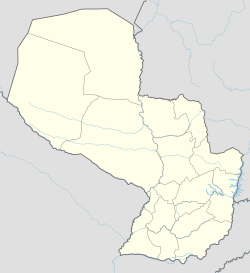Ayolas, Paraguay
| Ayolas | |
|---|---|
| Coordinates: 27°24′0″S 56°54′0″W / 27.40000°S 56.90000°WCoordinates: 27°24′0″S 56°54′0″W / 27.40000°S 56.90000°W | |
| Country | Paraguay |
| Department | Misiones |
| Founder | 1840 by don Patricio Aquino |
| Government | |
| • Intendente Municipal | Carlos María Arrechea Ortiz (ANR) |
| Area | |
| • Total | 122 km2 (47 sq mi) |
| Elevation | 70 m (230 ft) |
| Population (2008) | |
| • Total | 67,487 inhab |
| • Density | 622/km2 (1,610/sq mi) |
| Time zone | -4 Gmt |
| Postal code | 4830 |
| Area code(s) | (595) (72) |
Ayolas is a city in the department of Misiones, Paraguay. It is also the name of the district that the city is located in.
The city takes its name on behalf of Juan de Ayolas, second of Pedro de Mendoza, who founded Puerto la Candelaria, now Fuerte Olimpo, on the Paraguay River. He is believed to have been killed by chaco Indians, because he disappeared and never was heard of again.
Ayolas is located on the south of the country, near the towns of Santiago, San Juan Bautista and San Ignacio. It's a very simple fishing town, located 310 km away from Asunción, on the Paraguayan River.
In the summer, the maximum temperature is about 39°C, the minimum in winter is 0°C generally. The annual media is around 21°C.
Ayolas has a population of 15,219 inhabitants, from which 7,749 are male and 7,470, female. In the rural area there are 10,851 and in the urban area, 4,368 people; being the second city most inhabited of the department, after San Ignacio.
The city of Ayolas was founded in 1840 by Patricio Aquino, on a request made by José Gaspar Rodríguez de Francia.
In Ayolas, the Binational Entity of Yacyreta is located within the city area. When the dam was being built, the city was projected from scratch right next to the original town settlement (also known as "el pueblo" locally) so that the work force could be properly lodged. As such the Villa Permanente was raised in 1979 as a model town with 4 basic house models in a very organize arrangement, as well as modern schools, malls, water treatment plant, hospital, Police stations and a bus terminal. As the dam project advanced and more work force was needed the same process led to the creation of the “Mil viviendas” (Thousand houses) or "Nucleo 1" and then "Nucleo 2" housing neighborhoods in the mid 80s. These housing solutions was offered free of charge to workers to encourage them to move from more populated cities. In most cases the regular utilities as potable water, electricity and phone where covered by the employer, at least until the late 90s.
...
Wikipedia

